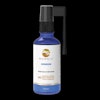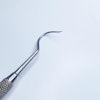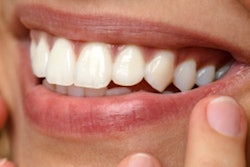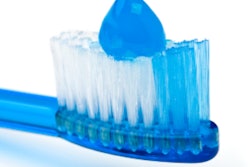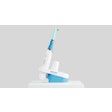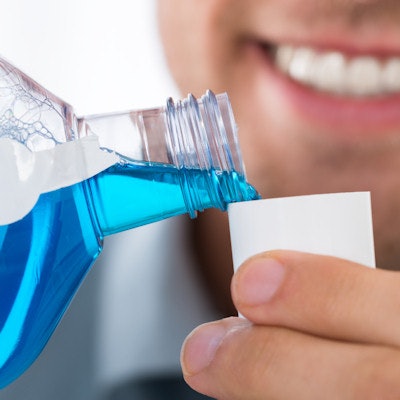
Rinsing with chlorhexidine for several weeks is an effective way to reduce plaque, according to a new systematic review. Those who used the rinse had significantly lower levels of plaque and also reduced gingival inflammation and bleeding, researchers found.
Chlorhexidine is considered the gold standard mouthwash for combating oral diseases, so the researchers wanted to see if the rinse lived up to its reputation. To find out, Patrice James, BDS, from the Cork University Dental School and Hospital in Ireland, and colleagues reviewed more than 50 scientific studies that included thousands of participants. They published their findings in the Cochrane Database of Systemic Reviews (March 31, 2017).
"Chlorhexidine mouthrinse is effective in reducing gingivitis and plaque when used as an adjunct to regular mechanical oral hygiene procedures for four weeks or longer," the authors wrote. "The consistency of effect ... was remarkable though not surprising considering that chlorhexidine mouthrinse has long been regarded as the gold standard of antimicrobial mouthrinses."
Chlorhexidine reduces plaque, inflammation
Flossing daily and brushing twice per day may successfully prevent oral diseases for most people, but sometimes the standard preventive routine is not enough. When brushing and flossing don't work, dentists sometimes recommend chlorhexidine mouthwash as an adjunct therapy. Therefore, the researchers of the current study wanted to determine if regular rinsing with chlorhexidine to help prevent caries and gum disease was supported by scientific evidence.
After searching the literature, they included 51 studies with a total of 5,345 participants for their review. All the included studies were randomized controlled trials that compared a chlorhexidine mouthwash with either a placebo/control mouthwash or no mouthwash at all. They also only included studies in which the rinse was used in addition to toothbrushing.
The majority of studies evaluated rinsing twice per day with 0.2% chlorhexidine in a volume of 10 mL of mouthwash. In addition, 0.12% and 0.1% chlorhexidine in a volume of 15 mL of mouthwash also were frequent concentrations.
| The effect of chlorhexidine rinse on plaque and gingivitis | ||
| At 4-6 weeks | At 6 months | |
| Plaque, measured by 8 different indexes or modifications of indexes, most commonly the Plaque Index of Silness and Löe or the Turesky modification of the Quigley-Hein index | 1.45 mean reduction in plaque compared with both control groups (12 studies with 950 participants) |
1.59 mean reduction in plaque compared with placebo/control rinse group (9 studies with 1,933 participants) 0.68 mean reduction in plaque compared with no rinse group (2 studies with 142 participants) |
| Mild gingival inflammation, measured by the Gingival Index of Löe and Silness | 0.21 mean reduction in inflammation compared with both control groups (10 studies with 805 participants) |
0.20 mean reduction in inflammation compared with both control groups (13 studies with 2,616 participants) |
| Mild gingival bleeding, measured by 5 different indexes or modifications of indexes, including Gingival Index of Löe the and Silness, Papillary Bleeding Score, and Papillary Bleeding Index | 0.56 mean reduction in bleeding compared with both control groups (8 studies with 649 participants) |
0.72 mean reduction in bleeding compared with both control groups
(8 studies with 1,132 participants) |
After reviewing the studies, the researchers found chlorhexidine mouthwash significantly reduced plaque compared with the two control subgroups. They also determined that the concentration of chlorhexidine didn't impact the effectiveness of the rinse, and they deemed the evidence as high-quality.
High-quality evidence also supported that chlorhexidine mouthwash significantly reduced mild gingivitis. However, there was not enough evidence to determine the rinse's effect on moderate to severe levels of the disease, the authors noted, and they did not consider the slight reduction of mild gingivitis to be clinically important.
Problems with studying chlorhexidine
Because so many studies were included in the review, the authors cautioned that some of the results may not be as precise as they would have liked. For example, many of the studies used different scales to measure inflammation, bleeding, and plaque. Therefore, the researchers were unable to use one index for each category and, instead, had to measure the difference reported in each scale.
The included studies, however, did have some key differences. Foremost, they were conducted in many different countries and locations, with settings that varied from a periodontal dental clinic to a knitting factory. The studies also included different populations, including children, adults, and those with medical conditions or special needs that make traditional preventive routines difficult.
The authors also noted that plaque, inflammation, and bleeding measurements rely on a number of subjective factors, including varying force when probing, time between stimulus and outcome, and different responses to the same stimulus.
“Further research is very unlikely to change our confidence in the estimate of the effect.”
In addition, chlorhexidine mouthwash has a number of adverse effects, including leaving brown stains on teeth and oral tissues, according to the authors. This is problematic for patients and also for researchers, because it makes it practically impossible to blind study administrators to which rinse contains chlorhexidine. Nevertheless, the researchers are confident that the study results are still reliable and high-quality.
"Despite most studies included in the meta-analyses being assessed as at a high risk of bias we did not downgrade the ... assessment for gingivitis and plaque," the authors wrote. "This is because we believe that further research is very unlikely to change our confidence in the estimate of the effect for these outcomes."
Although the evidence strongly weighs in favor of chlorhexidine mouthwash for short-term use, the authors still believe more trials are needed. In particular, they hope future studies will evaluate how well the rinse works in individuals with moderate or severe levels of gingival inflammation, as well as if it is effective in lower concentrations for long-term use.
Nevertheless, rinsing with chlorhexidine appears to be effective at reducing plaque and, to a lesser degree, inflammation and bleeding. Professionals, however, should be careful when having patients use it for an extended period of time, the authors cautioned.
"This review found high-quality evidence of a large reduction in dental plaque with chlorhexidine mouthrinse used as an adjunct to mechanical oral hygiene procedures for four to six weeks and six months," the authors concluded. "Using chlorhexidine mouthrinse for longer periods of time in individuals with special care needs who cannot maintain an adequate level of plaque control using mechanical cleaning methods alone must be carefully weighed against the adverse effects associated with its use."
